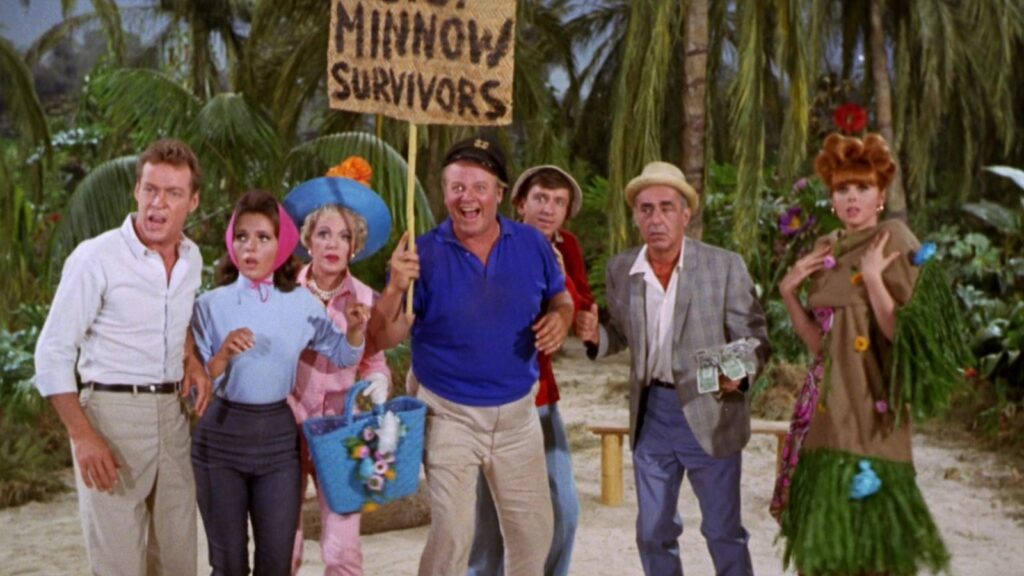
We may receive a commission on purchases made from links.
There are many ways to interpret Sherwood Schwartz’s 1964 sitcom “Gilligan’s Island.” Author Paul A. Cantor once wrote in his 2001 book “Gilligan Unbound: Pop Culture in the Age of Globalization” that the series presents an idealized version of American democracy. Cantor’s thesis pointed out that the show’s seven castaways all came from different American classes — there were two millionaires, a professor, a farmer, a pair of military men, and an entertainer — but when they were forced to live on a deserted island together, they became fast friends. Not only that, but they also thrived. Schwartz was said to have confirmed Cantor’s thesis in an obituary printed in the Washington Post.
Many (including this author) see a Sisyphean element to “Gilligan’s Island.” Every episode begins with hope. Often, a new person or object will wash ashore, offering the castaways an opportunity for escape. The opportunity is then consistently squandered, however, often through Gilligan’s bumbling. Every episode subsequently ends on a note of despair, with the seven castaways lamenting their inability to leave the island. Gilligan is almost a cosmic being, a holy fool designed to unwittingly offer punishment to those around him. “Gilligan’s Island” takes place in a cartoon world that is darkly undergirded by hopelessness.
There is also a fan theory, one that often appears in casual analyses of “Gilligan’s Island,” that the seven stranded castaways are being cosmically imprisoned on Gilligan’s Island because of their sins. Indeed, because there are seven of them, one might be quick to observe that each one of them could be emblematic of the Seven Deadly Sins. While Sherwood Schwartz felt that “Gilligan’s Island” was a perfect democracy, he also admitted to NPR in 2008 that each character did indeed have a sinful flaw derived from the Seven Deadly Sins.
The seven castaways on Gilligan’s Island represent the Seven Deadly Sins
In the NPR rundown, Szhwartz was specific about which castaway represented which Deadly Sin. The Professor (Russell Johnson) possessed expertise, but often let his knowledge give way to Pride. The millionaire Mr. Howell (Jim Backus), because he hoarded wealth, was the handy avatar for Greed. Although she wasn’t outwardly sexual toward any of her island compatriots, Ginger (Tina Louise) was often flirtatious and libidinous, making her the avatar for Lust. Mary Ann, a simple country denizen, often expressed Envy when looking at her fellow castaways. According to Schwartz, it was Mrs. Howell (Natalie Schafer) who was most often angry and impatient, giving her the mantle of Wrath. Actor Alan Hale wasn’t allowed to lose weight while playing the Skipper, implying that he was the avatar of Gluttony. And, of course, the hapless, unmotivated Gilligan (Bob Denver) was the representative for Sloth.
This is a fun theory, although it doesn’t hold a lot of credence with Mrs. Howell. Mrs. Howell was not a wrathful character; she was funny because of her cluelessness and class unawareness. She might have been guilty of Pride or Greed, but not Wrath. If anything, the Skipper is the wrathful character, most often losing his patience with Gilligan and hitting him with his hat. Also, the Skipper may have been fat, but he never outwardly expressed much Gluttony. Perhaps there were no Gluttons on Gilligan’s Island, and two avatars for Greed.
If one wanted to spin the Seven Deadly Sins theory out into more general theories of ancient literary tragic flaws (called Hamartia in Greek theater), the perhaps this interpretation would work better. Perhaps the characters all exhibit self-doubt about their ability to escape or hubris in their assumed mastery over the elements; they didn’t have to go on that three-hour tour. Tragic flaws, however, typically only come from tragic figures, and the “Gilligan’s Island” crew are all comedy characters.
Other Gilligan’s Island theories
If we’re talking about stock comedy characters, then the Minnow survivors aren’t Deadly Sins or tragic heroes, but more likely archetypes from centuries-old Commedia dell’Arte traditions. Commedia, for those who haven’t studied it yet, typically employed a limited number of stock characters for their stories, and such characters usually wore the same costumes and/or masks from production to production. The most famous Commedia archetype is Arlecchino, a bumbling clown. His name would eventually be translated to “Harlequin.”
Gilligan is clearly Arlecchino. The Skipper, meanwhile, fits into the braggart military mold of Scaramuccia. Mr. Howell, an older, wealthy man, is clearly Pantolone, and the Professor, a learned type, is Il Dottore. Ginger might be Gianduja, although she is a peasant character who typically drinks too much. Sadly, there is no “movie star” equivalent in Commedia. Mary Ann, however, fits nicely into the role of Columbiana, a perky maid-like figure. Mrs. Howell, being a counterpart to Mr. Howell, is merely a secondary Pantolone.
Actual scholars of Italian theater, however, might want to chime in with their own theories.
There is also the post-modern interpretation of the characters as presented in Tom Carson’s ambitious 2003 novel “Gilligan’s Wake,” which gives each of the castaways elaborate, and often very tragic, backstories. Gilligan was mentally unwell in that rendition. Mr. Howell was guilty of many crimes, and Mrs. Howell barely tolerated her husband. Ginger had enaged in secret affairs with known celebrities, while the Skipper had lost friends in combat.
That so many theories exist about “Gilligan’s Island” is simply proof of how deeply the show has penetrated into the mass consciousness. It will live forever.


